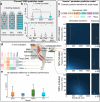An active electronic, high-density epidural paddle array for chronic spinal cord neuromodulation
- PMID: 40104941
- PMCID: PMC11920892
- DOI: 10.1088/1741-2552/adba8b
An active electronic, high-density epidural paddle array for chronic spinal cord neuromodulation
Abstract
Objective. Epidural electrical stimulation (EES) has shown promise as both a clinical therapy and research tool for studying nervous system function. However, available clinical EES paddles are limited to using a small number of contacts due to the burden of wires necessary to connect each contact to the therapeutic delivery device, limiting the treatment area or density of epidural electrode arrays. We aimed to eliminate this burden using advanced on-paddle electronics.Approach. We developed a smart EES paddle with a 60-electrode programmable array, addressable using an active electronic multiplexer embedded within the electrode paddle body. The electronics are sealed in novel, ultra-low profile hermetic packaging. We conducted extensive reliability testing on the novel array, including a battery of ISO 10993-1 biocompatibility tests and determination of the hermetic package leak rate. We then evaluated the EES devicein vivo, placed on the epidural surface of the ovine lumbosacral spinal cord for 15 months.Main results.The active paddle array performed nominally when implanted in sheep for over 15 months and no device-related malfunctions were observed. The onboard multiplexer enabled bespoke electrode arrangements across, and within, experimental sessions. We identified stereotyped responses to stimulation in lower extremity musculature, and examined local field potential responses to EES using high-density recording bipoles. Finally, spatial electrode encoding enabled machine learning models to accurately perform EES parameter inference for unseen stimulation electrodes, reducing the need for extensive training data in future deep models.Significance. We report the development and chronic large animalin vivoevaluation of a high-density EES paddle array containing active electronics. Our results provide a foundation for more advanced computation and processing to be integrated directly into devices implanted at the neural interface, opening new avenues for the study of nervous system function and new therapies to treat neural injury and dysfunction.
Keywords: epidural electrical stimulation; hermetic electronics; high density array; implanted device; neuromodulation; spinal electrophysiology.
Creative Commons Attribution license.
Conflict of interest statement
SRP, JSC, RD, and DAB have patents pending regarding the recording of spinal electrophysiological signals during spinal cord stimulation (PCT-US2022-034450: ‘A novel method to modulate nervous system activation based on one or more spinal field potentials’). BM, KA, GC have patents and pending patents related to high-resolution spinal cord stimulator devices (US-11 116 964-B2: ‘Multi-electrode array with unitary body’, 11 027 122: ‘Spinal cord stimulation method to treat lateral neural tissues’, US-11 395 924-B2: ‘Implantable devices with welded multi-contact electrodes and continuous conductive elements’). Micro-Leads Medical is a commercial company developing precision neuromodulation therapeutic devices and BM, KA, GC, and YI are shareholders or have stock options in Micro-Leads.
Figures





Update of
-
An active electronic, high-density epidural paddle array for chronic spinal cord neuromodulation.bioRxiv [Preprint]. 2024 Oct 2:2024.05.29.596250. doi: 10.1101/2024.05.29.596250. bioRxiv. 2024. Update in: J Neural Eng. 2025 Mar 19;22(2). doi: 10.1088/1741-2552/adba8b. PMID: 38853820 Free PMC article. Updated. Preprint.
References
-
- Boston Scientific Surgical leads directions for use. 2020. (available at: www.bostonscientific.com/content/dam/elabeling/nm/92395562-01_B_Surgical...)
MeSH terms
Grants and funding
LinkOut - more resources
Full Text Sources
